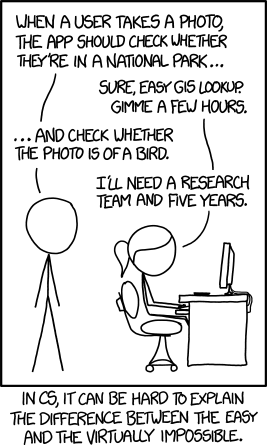This content is incomplete and may be inaccurate, feel free to look around & please check back later for updates.
There are a few things in the SaaS development pipeline that can make a product complex from the beginning. These are the points that a seasoned developer will instantly increase estimates which will sound unreasonable at the time. Infact there’s always a relevant XKCD comic which is shown alongside this section. Amazingly this is actually something AI has made infinitely easier.
Another example I have heard over the years is a thought experiment around building an application that can make coffee. For a non-engineer they will list out the basic steps for example – turn on the machine, grind the beans, compress them, put them in the machine, place a cup in place, press a button. But to a developer it’s infinitely more complex than that, as a computer doesn’t know what a bean is, what a cup is, how much a cup holds, what a liquid is, what volume is. The developer has to create these.
In the SaaS world the complexities typically revolve around globalisation/scale. When the platform or app needs to be in two languages, or when a file is saved in one timezone, and that time has to be accurate in another. Whenever any payments are involved and there’s different currencies. Even if there’s one user who is a European citizen who will be using the product. How many users there will be online all at the same time, and how quickly will they sign up. All of these add complexity.
So the answer (for your startup) is to reduce as many of these as possible. Push them down the pipeline, but it’s important to mention they need to be considered, and when they will be arriving.
What is SaaS?
This is one of the most asked questions I get from anyone not in the IT/investment industries. A SaaS is generally any online website that multiple people can log in to and use as if it were an application sitting on their laptop or phone. Usually towards the more business side of things (Salesforce, Xero, Google Sheets) but it can include consumer facing applications also (Facebook, Canva, ChatGPT). Even though something like instagram is technically a SaaS you wouldn’t really refer to it as that.
They are typically scalable meaning it’s the same experience for each user whether there’s only one or millions, with one requirement I read was that should allow the client to self-subscribe without any assistance.
So if you’re building any website that acts as a tool & allows multiple users to log in use it, you can typically call it a SaaS platform.
Reducing costs & time
Dynamic screen size example – drop shadows, responsive, font icons, skeuomorphic -> flat/material design
Data bandwidth example – server side -> ajax/dynamic -> server side rendering
Team sizes & skills – corporate tools & methods, overcapitalise
